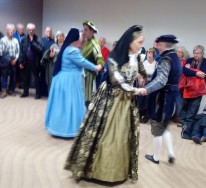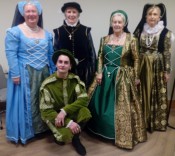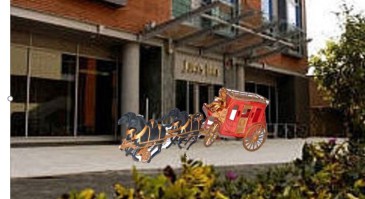
A TUDOR CHRISTMAS
On Wednesday, 12 December, we leapt back five centuries to life and dancing in Tudor England. An exhibition of courtly dancing – in full costume – entertained us with their elegance and courtliness. Their costumes were magnificent, yet we learnt afterwards that England had no national costume - we just kept copying other countries and never developed our own style.
However, we learnt that dresses always had a square neckline and that iron corsets were made by blacksmiths and worn with a chemise underneath. The top and front part of dress was in one piece but only the material on show was expensive. The rest, where not seen, was cheap.
Men wore capes (half cloaks) for decoration and tied them in place over one shoulder. Hats were always worn and we learnt the correct way to doff them (keeping the inside hidden for fear of exposing their nits. They were made of wool and their popularity proved a boost to the economy. Sleeves came separately and our pretend male, Sandy, showed how sleeves were tied to his/her jacket.
King Henry was reputed to change his clothes 14 times a day and, like all men and ladies, he needed servants to help him dress. Dressing for court could take ladies up to three hours! Their clothes were pinned together by the servants – “pin money” described the allowance given them by their father/husband to purchase pins for their clothes.
Clothing was so stiff that you couldn’t raise your arms above shoulder level !
Tudor times were very smelly so ladies carried posies of flowers (men wore button holes) so they could bury their noses into sweet smelling flowers to avoid the smells.
Queen Elizabeth liked silk stockings (which only came up to the knee) and men wore similar stockings tied to their clothes to keep them up. Ladies used garters.
The queen was said to wash only twice a year. Her face make-up was a paste of lead and egg white which dried stiff on her face and had to be scraped off at night! She loved sugar and consumed wine and sugar mixed in equal proportions from a goblet by dipping her finger and then sucking it. No wonder her teeth were rotten! Evidently she died while sucking her finger!
Glass was very expensive, easily broken and difficult to replace so only the very rich used glass drinking goblets. Most goblets were pottery – green was the Tudor colour - and they had to conform to a legally standard volume.
In early Tudor times, food was served on hunks of bread which the servants subsequently ate or gave to the poor at the gate. The bread was gradually replaced by wooden trenchers which were usually square with a shallowed out centre and a hole for salt in one corner. Then, of course, the wood was replaced by pewter which could be polished up to look like silver.
Everyone carried their own knife and at meal times the gentleman would use his to give ladies the best cut. Forks were not yet invented so knife and spoon were the tools.
At mealtimes all were provided with sweet smelling finger bowls to cleanse their fingers which they then wiped on their own napkins draped over their left shoulders.
Every gentleman carried his own knife, spoon, trencher and napkin. Chris (one of the dancers) showed us how he carried his knife within his clothes. He also had a purse strapped round his waist – but this could easily be removed by a pickpocket with a sharp knife. Ladies never walked the streets alone so were safer and their valuables were in any case worn, so difficult to snatch.
Tudors had no banks so they kept their money and gold in lockable chests and trunks. However, wealth was displayed in many ways – having very clean white underwear proved you had lots of servants which was considered a mark of wealth (washed underwear was hung out to dry on lavender bushes so as to absorb their sweet smell!). Outer clothes were never washed – it was not possible.
All visible skin was washed daily and hair was cleansed with natural oils from sweet-smelling bushes such as lavender. Wiping silk over their hair was also reputed to help. Two wooden combs were used, the smaller one being for removing nits.
A “House of Easement” was available for toilet purposes. King Henry’s had fabric on the seat and he would be accompanied there by his “Master of the Stool” – a very high office as the master spent private time with the king when the king was using the facility!!!
Horn was much used. We handled a child’s instructional plaque which showed the alphabet and the Lord’s Prayer. It was made of horn protected by a laminate-like surface (mica).
Time was slipping by and we were all by now exhausted by so much fascinating information. So we thanked these ladies and gentlemen who had so kindly crossed a 500-year time zone to share their lives with us and we wished them well as their coach arrived at the front door of Jurys (see below) for their time travel home.



